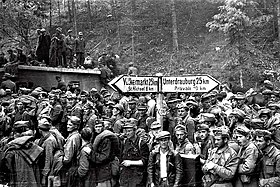| Part of the aftermath of World War II in Yugoslavia | |
 World War Two prisoners of war at Bleiburg, Austria (1945) | |
| Date | May 1945 |
|---|---|
| Location | March to Austrian border and back through Yugoslavia |
| Type | Military operations |
| Motive | Revenge for atrocities, collaboration and occupation |
| Target | Mainly Ustaše, Slovene Home Guard and German prisoners of war and Croat, Bosniak, and Slovene civilians associated with atrocities and collaboration |
| Participants | Yugoslav Partisans |
| Outcome | Summary executions, massacres, death marches |
| Deaths | c. 70,000–100,000 |
| Litigation | None, officially suppressed |
| Part of a series on |
| Aftermath of World War II in Yugoslavia |
|---|
| Main events |
| Massacres |
| Camps |
The Bleiburg repatriations (see terminology) were a series of forced repatriations from Allied-occupied Austria of Axis-affiliated individuals to Yugoslavia in May 1945 after the end of World War II in Europe. During World War II, Yugoslavian territory was either annexed or occupied by Axis forces, and as the war came to end, thousands of Axis soldiers and civilian collaborators fled Yugoslavia for Austria as the Yugoslav Army (JA) gradually retook control. When they reached Austria, in accordance with Allied policy, British forces refused to take them into custody and directed them to surrender to the JA instead. The JA subsequently subjected them to death marches back to Yugoslavia, where those who survived were either subject to summary executions or interned in labor camps, where many died due to harsh conditions. The repatriations are named for the Carinthian town of Bleiburg, where the initial British refusal to accept the surrenders occurred, and from which some repatriations were carried out.
On 3 May 1945, the government of the Independent State of Croatia (NDH), a fascist puppet state established in German-occupied Yugoslavia which had undertaken genocidal campaigns against its minority populations, reducing their numbers by the hundreds of thousands, decided to flee to Austria. They initiated the evacuation by ordering the Croatian Armed Forces (HOS) to move there as soon as possible, in order to surrender to British forces. The Axis-aligned Slovene leadership issued similar orders to the Slovene Home Guard on the same day. These forces, accompanied by civilians, joined the German Army Group E and other Axis units in withdrawal; the latter included the XV SS Cossack Cavalry Corps and the remnants of the Montenegrin Chetniks organized in the HOS-commanded Montenegrin National Army.
In the week after the German Instrument of Surrender, which marked the formal end of World War II in Europe, collaborationist forces in Yugoslavia continued to battle the Partisans to avoid encirclement and keep escape routes open. The Slovene-led columns fought their way to the Austrian border near Klagenfurt on 14 May. Their surrender was accepted by the British and they were interned in the nearby Viktring camp. When one of the columns of fleeing HOS troops, who were intermingled with civilians, approached the town of Bleiburg on 15 May, the British refused to accept their surrender. They directed them to surrender to the Partisans, which the HOS leadership did after short negotiations. Other Axis prisoners in British captivity were repatriated to Yugoslavia in the following weeks. The repatriations were canceled by the British on 31 May, following reports of massacres in Yugoslavia. The Yugoslav authorities moved the prisoners on death marches throughout the country to internment and labor camps. Mass executions were carried out, the largest of which were in Tezno (estimated at 15,000 Croatian prisoners of war),[1] Kočevski Rog, Huda Jama and Macelj. In the ensuing Communist rule in Yugoslavia, these massacres and other abuses after the repatriations were a taboo topic and information about the events was suppressed. Public and official commemoration of the victims, which included civilians, did not begin until several decades later.
Historians have been unable to accurately ascertain the number of casualties during and after the repatriations; exact numbers have been the subject of much debate, and assessments are typically in the ranges of tens of thousands. Historians and investigations in Slovenia and Croatia indicate that most of the victims were members of Croatian, Slovene, Montenegrin and Serb collaborationist armed forces.[2][3][4] Following the breakup of Yugoslavia, an annual commemoration for the victims has been held in Bleiburg, but has drawn considerable controversy due to Ustaše symbols at the event. Croatian authorities have variously either endorsed that commemoration or initiated other commemorations in Slovenia, while the Austrian authorities have increasingly made moves to prevent it from further happening.